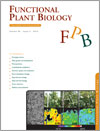
Functional Plant Biology
Volume 39 Number 3 2012
FP11156 Grapevine varieties exhibiting differences in stomatal response to water deficit
Knowledge on variety traits underlying responses to water stress remains scarce in grapevine, limiting irrigation and breeding strategies to optimise water use. We aimed at characterising different grapevine varieties on the basis of leaf temperature (Tleaf) and water potential (Ψpd) to better understand stomatal regulation. We show that different genotypes had different Tleaf for similar water potential suggesting variation in stomatal control. This should be accounted for when managing irrigation.
FP11245 Effects of drought and high temperature stress on synthetic hexaploid wheat
Drought and high temperatures cause significant yield losses in wheat. Independent and combined effects of drought and high temperature stress were quantified on synthetic wheat genotypes. Combined effects of drought and high temperature stress were more detrimental than the individual stresses. Stress tolerant synthetic wheat genotypes identified in this study can be used to improve drought and high temperature tolerance in wheat.
FP11231 The impact of winter flooding with saline water on foliar carbon uptake and the volatile fraction of leaves and fruits of lemon (Citrus × limon) trees
The combination of winter flooding with saline water heavily, yet transiently, damages the primary metabolism of a high-value lemon orchard, whereas it enhances emission and content of abundant foliar and fruit volatiles. These results suggest the unexpected resilience of sensitive crops to salinity coupled with flooding, and also indicate a qualitative change in secondary metabolites of importance for pollination and induced plant self-defence, and for the quality of fruit production.
FP11234 Physiological and morphological factors influencing wear resistance and recovery in C3 and C4 turfgrass species
Wear resistance and recovery are the most sought after characteristics in turfgrass species for most applications. Therefore, C4 turfgrass wear resistance and recovery was tested in a controlled environment and the results were plotted against main plant tissue constituents. Lignin and carbohydrate concentrations proved to be the compounds most closely correlated with wear resistance and recovery respectively, with a species-specific equilibrium.
FP11253 Preliminary characterisation of two early meiotic wheat proteins after identification through 2D gel electrophoresis proteomics
Proteomics is a powerful tool for identifying novel protein species. By using 2D gel electrophoresis, five proteins differentially expressed during meiosis in bread wheat were identified; two were characterised as DNA-binding proteins. This study shows the potential of proteomics as a protein discovery tool in plant species, even where the genome is not completely sequenced. The preliminary characterisation of the two novel DNA-binding proteins earmarks these candidates for further study.
FP11218 Arbuscular mycorrhisation with Glomus irregulare induces expression of potato PR homologues genes in response to infection by Fusarium sambucinum
Arbuscular mycorrhizal fungi form symbiosis with roots of a wide range of plants improving their growth by increasing mineral uptake. These fungi induce defense responses in potato plants to protect against infection with the pathogen Fusarium sambucinum. As a result, arbuscular mycorrhizal fungi significantly suppressed disease severity of Fusarium sambucinum on potato plants compared with those infected and non-mycorrhized plants.
FP11240 Tomato response to legume cover crop and nitrogen: differing enhancement patterns of fruit yield, photosynthesis and gene expression
Crops can distinguish between organic and inorganic sources of nitrogen (N), one of the most important nutrients required by plants. Tomato responses at the whole-plant (yield), leaf (photosynthesis) and molecular (gene expression) levels to the legume cover crop, hairy vetch, were shown to be a result of cues by molecules other than just N. These findings suggest that N management by on-site production of legume cover crops in sustainable cropping systems offer additional physiological advantages to crops than those derived from inorganic N alone.
FP11256 Responses to low phosphorus in high and low foliar anthocyanin coleus (Solenostemon scutellarioides) and maize (Zea mays)
Anthocyanin accumulation is a common response of leaves to phosphorus deficiency, although the utility of this response is unknown. We evaluated red and green leafed phenotypes of maize and coleus under phosphorus deficiency, and found no clear physiological benefit from anthocyanins. More research is needed, for example comparing constitutive and induced anthocyanin biosynthesis, to understand how anthocyanin production might help protect utrient-deficient plants.



